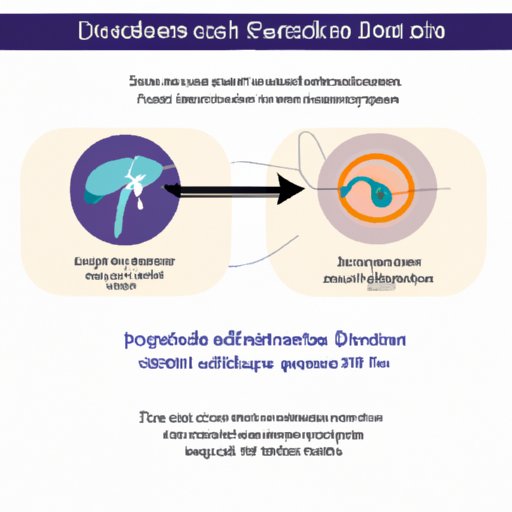
Introduction
CJD disease, also known as Creutzfeldt-Jakob disease, is a rare, degenerative, and fatal brain disorder. It can affect individuals of any age, gender, or ethnicity, and typically progresses rapidly, leading to significant physical and cognitive decline. Given the severity of the disease, it’s crucial that we understand it more deeply. This article will cover the causes, symptoms, and treatment options for CJD disease, as well as its impact on the brain, patient journey, and ways to prevent it.
CJD Disease Explained: Causes, Symptoms, and Treatment Options
CJD disease is caused by an abnormal accumulation of a protein called prion, which affects the structure and function of brain cells. It’s believed that the protein can mutate and become infectious, leading to the development of the disease. While some cases of CJD disease are genetic, the majority occurs spontaneously in people without any prior family history.
The typical symptoms of CJD disease include rapid cognitive decline, neurological issues such as involuntary muscle movements, difficulty with coordination, and changes in personality or behavior. In advanced stages, individuals often experience significant memory loss, eventual coma, and death within a year of diagnosis. Unfortunately, there is no known cure for CJD disease. However, some medications can help reduce symptoms, while others focus on offering palliative care to ease the patient’s pain and discomfort.
The Anatomy of CJD Disease and How It Affects the Brain
CJD disease affects the brain, and the protein accumulation causes widespread damage. The protein deposits form plaques that destroy brain tissue, which then leads to a progressive loss of functionality in various regions of the brain. The accumulation of these proteins ultimately leads to the death of brain cells, resulting in the symptoms associated with the disease. CJD disease can alter one’s vision, speech, or ability to move, and can also cause systemic issues such as weight loss and hypotension.
The diagnosis of CJD disease is typically confirmed by a brain biopsy or other diagnostic tests such as MRI or EEG. However, some of these tests may not reveal abnormalities in early stages, leading to challenges in early detection of the disease.
Living with CJD Disease: A Patient’s Journey
Living with CJD disease can be incredibly challenging for patients and their families. As the disease progresses rapidly, patients may experience significant cognitive and physical limitations, as well as changes in mood, behavior, and personality. It’s important to get support from family, friends, and healthcare providers, and to find ways to make the most of the time that is left. This involves making lifestyle changes, seeking out specialized care facilities that can manage the patient’s needs, and finding ways to maintain a positive outlook amidst the challenges.
Caregivers of those with CJD disease play an essential role in managing symptoms, maintaining quality of life, and ensuring the patient remains comfortable. They must also follow a strict protocol when it comes to hygiene, nutrition, and avoiding exposure to other infections and diseases. It’s important for caregivers to take care of their health and well-being as well, and to seek out support groups or resources for more information on how to manage the patient’s care.
CJD Disease in Humans: Causes, Transmission, and Prevention
CJD disease can occur spontaneously or be inherited from family members. Knowing the genetic roots behind a patient’s disease can be helpful in understanding how and why it develops. Researchers have also identified other potential causes of CJD disease, including exposure to contaminated tissue like contaminated surgical instruments. However, these causes remain unproven, and most cases are still considered sporadic.
The prevention of CJD disease involves taking steps to minimize exposure to prion protein and other sources of contamination. It’s critical to maintain strict hygiene standards in the healthcare environment and to follow recommended sterilization guidelines. Individuals should also avoid consuming high-risk food items like raw brain, spinal cord, or lymph tissue from infected individuals. It’s important to note that research on CJD disease is ongoing, and new information regarding potential causes or prevention practices may emerge in the future.
Understanding the Differences Between CJD Disease and Similar Neurodegenerative Disorders
CJD disease is similar to other neurodegenerative disorders like Alzheimer’s disease, Parkinson’s disease, and multiple sclerosis. However, there are some key differences to consider when comparing these disorders. CJD disease affects the brain in a unique way by causing rapid cognitive and motor decline, and individuals often experience shortness of breath or other systemic symptoms. Other disorders may take years or decades to progress to a similar state.
Moreover, prion diseases like CJD disease result from exposure to infectious material, whereas other disorders may have a combination of genetic, environmental or other factors. Despite these differences, all neurodegenerative diseases can be devastating, and it’s essential to be proactive in detecting, diagnosing, and treating them early, when possible.
Conclusion
CJD disease is a rare and fatal brain disorder with no known cure. It’s crucial to understand the causes, symptoms, and treatment options for the disease, as well as its impact on the brain and patient experience. There are specific steps that individuals can take to prevent the disease, and caregivers can follow to manage symptoms and help maintain quality of life. Understanding the similarities and differences between CJD disease and other neurodegenerative diseases can help us identify early signs, get appropriate care, and offer support to those living with the disease.
If you or someone you know is struggling with CJD disease, know that there is support available. Reach out to national and local support groups or healthcare providers for more information or resources.




